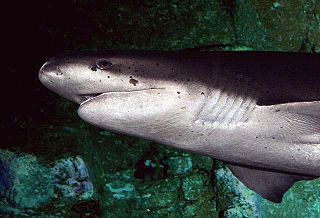
The Hexanchiformes are a primitive order of sharks, numbering just seven extant species in two families. Fossil sharks that were apparently very similar to modern sevengill species are known from Jurassic specimens.

Carcharodon is a genus of sharks within the family Lamnidae, colloquially called the "white sharks." The only extant member is the great white shark. The extant species was preceded by a number of fossil (extinct) species including C. hubbelli and C. hastalis. The first appearance of the genus may have been as early as the Early Miocene or Late Oligocene. Carcharocles megalodon is still argued by some paleontologists to be a close relative of Carcharodon carcharias - as well as being in the same genus. The megalodon's scientific name was originally "Carcharodon" megalodon, but more recently, the giant shark has been assigned by most scientists to either the genus Carcharocles or Otodus.

Leporinus is a genus of fish in the family Anostomidae native to South America. The fossil species Leporinus scalabrinii, known from the late Miocene of Entre Ríos in Argentina, has only recently been added to this genus after being misidentified as a species of primate under the name Arrhinolemur scalabrinii for over 100 years.

Myliobatis is a genus of eagle rays in the family Myliobatidae.

The Bombycidae are a family of moths known as silkworm moths. The best-known species is Bombyx mori (Linnaeus), or domestic silk moth, native to northern China and domesticated for millennia. Another well-known species is Bombyx mandarina, also native to Asia.
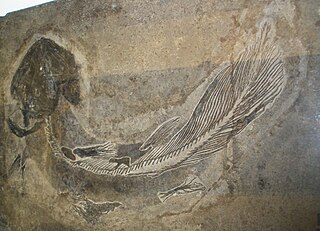
Coelacanthus is a genus of extinct marine coelacanths known from the late Permian period. It was the first genus of coelacanths described, about a century before the discovery of the extant coelacanth Latimeria. The order Coelacanthiformes is named after it.

Carcharias is a genus of mackerel sharks belonging to the family Odontaspididae. Once bearing many prehistoric species, all have gone extinct with the exception of the critically endangered sand tiger shark.
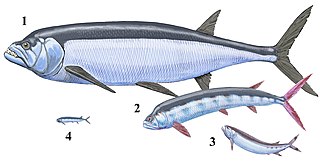
Ichthyodectiformes is an extinct order of marine stem-teleost ray-finned fish. The order is named after the genus Ichthyodectes, established by Edward Drinker Cope in 1870. Ichthyodectiforms are usually considered to be some of the closest relatives of the teleost crown group.
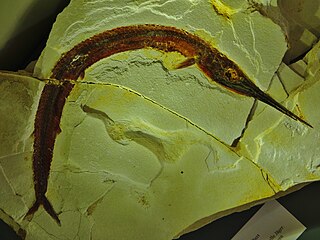
Belonostomus is a genus of prehistoric ray-finned fish that was described by Louis Agassiz in 1844. It is a member of the order Aspidorhynchiformes, a group of fish known for their distinctive elongated rostrums.
Cladocyclus is an extinct genus of marine ichthyodectiform fish from the middle Cretaceous. It was a predatory fish of about 1.20 metres (3.9 ft) in length.

Brannerion is an extinct genus of prehistoric marine bonefish. Fossils of the genus were found in the Romualdo Formation of the Santana Group, Araripe Basin, northeastern Brazil. It is considered a basal member of the Albuliformes.
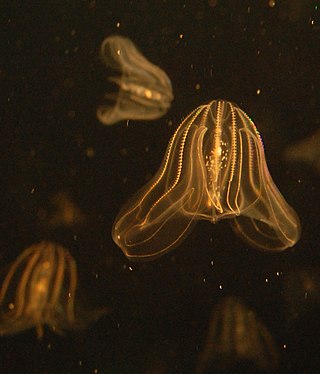
Bolinopsidae is a family of ctenophores.

Temnopleuridae is a family of sea urchins in the infraorder Temnopleuridea.

Charles Stokes was a London stockbroker who gained a reputation both as an amateur scientist and as an art collector.

Mellitidae is a family of sand dollars, in the echinoderm order Clypeasteroida. These irregular sea urchins bury themselves in soft sediment in shallow seas.
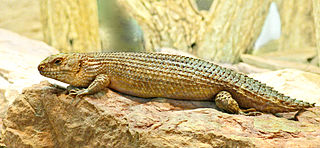
Egernia stokesii is a gregarious species of lizard of the Scincidae family. This diurnal species is endemic to Australia, and is also known as the Gidgee skink, spiny-tailed skink, Stokes's skink and Stokes's egernia. The species forms stable, long-term social aggregations, much like the social groups seen in mammalian and avian species. This characteristic is rarely found in the Squamata order, but is widespread within the Australian subfamily of Egerniinae skinks. Populations of E. stokesii are widely distributed, but fragmented, and occur in semi-arid environments. There are three recognised subspecies. The conservation status for the species is listed as least concern, however, one subspecies is listed as endangered.

Mellitella is a genus of echinoderms belonging to the family Mellitidae.
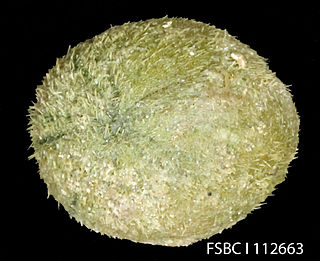
Brissopsis is a genus of echinoderms belonging to the family Brissidae.

Encope is a genus of echinoderms belonging to the family Mellitidae.

Echinodiscus is a genus of sand dollars within the family Astriclypeidae. There are currently 14 species assigned to the genus, with a majority being extinct.



















